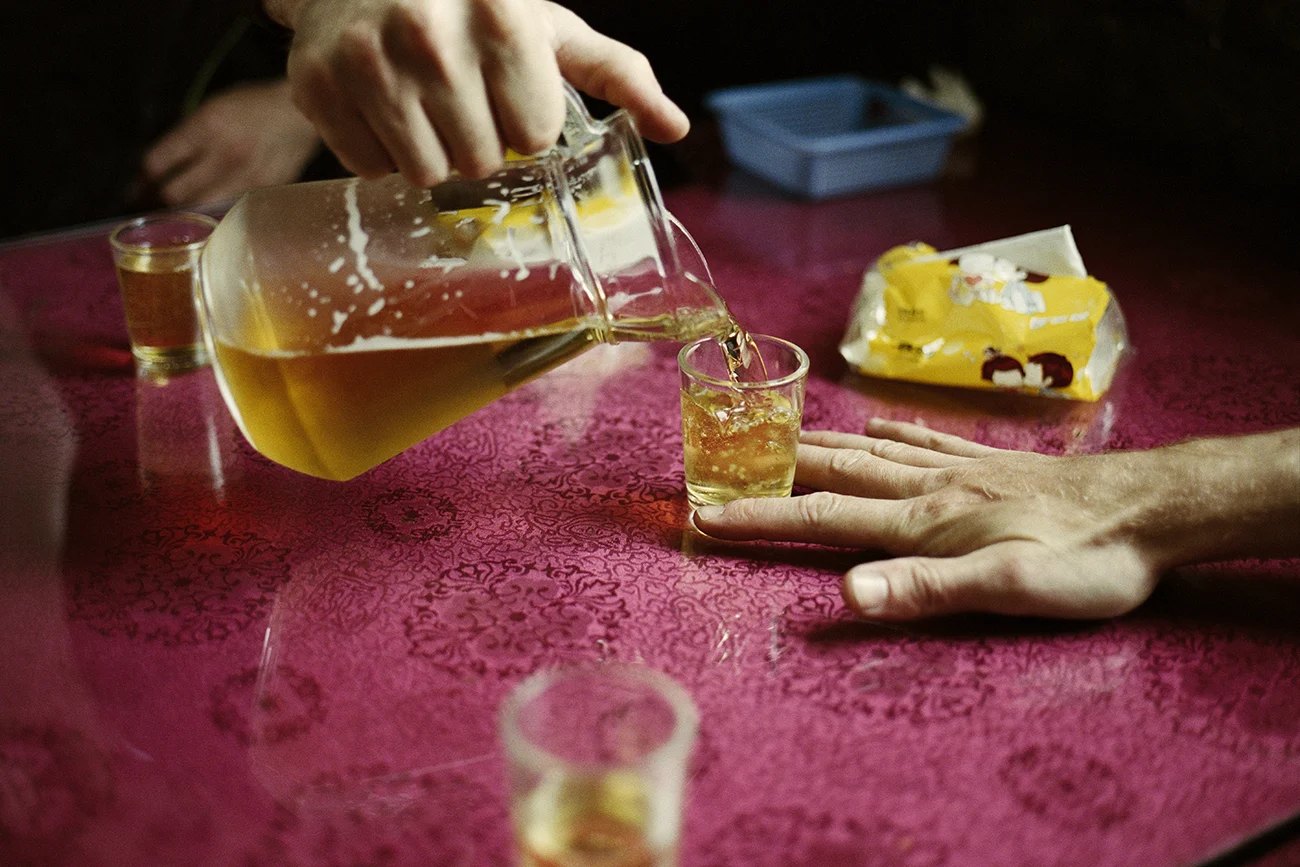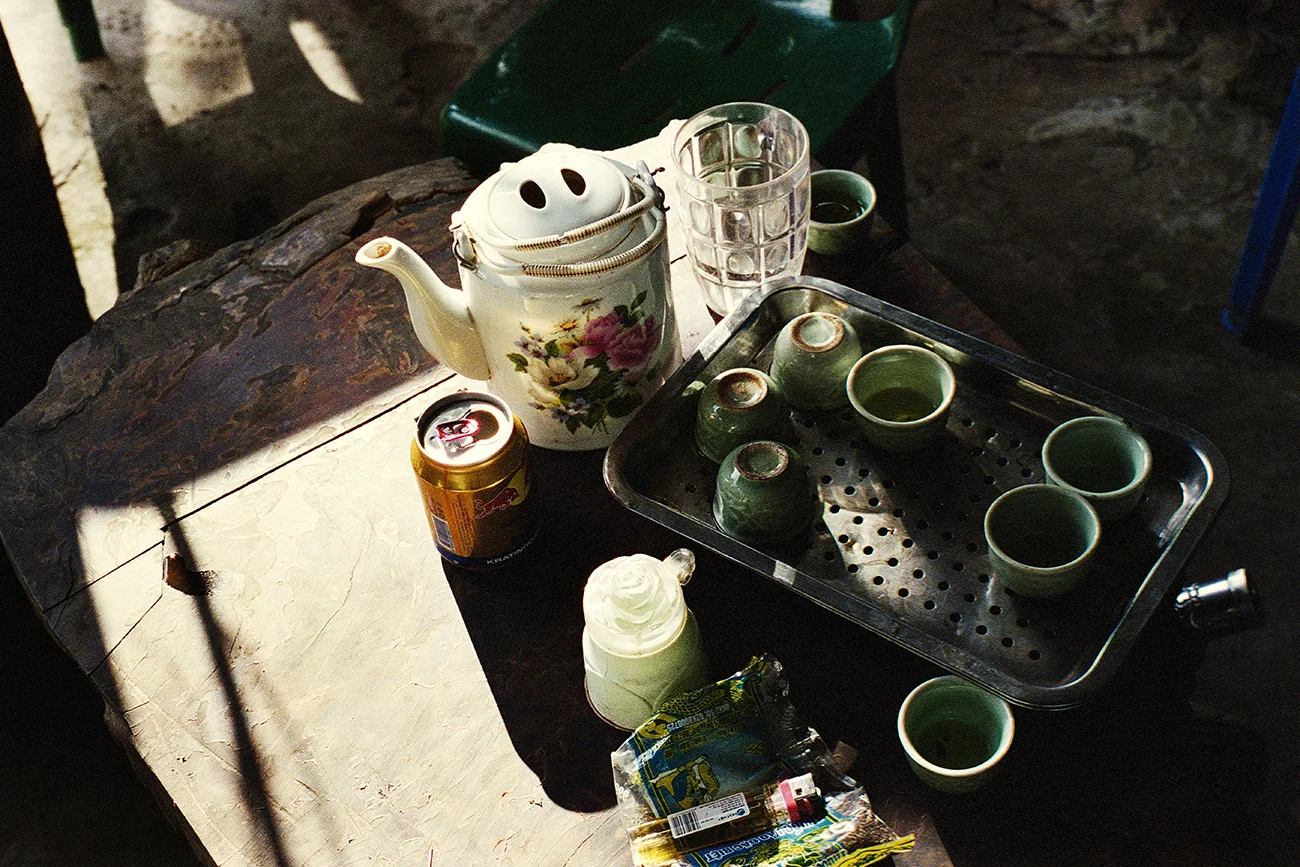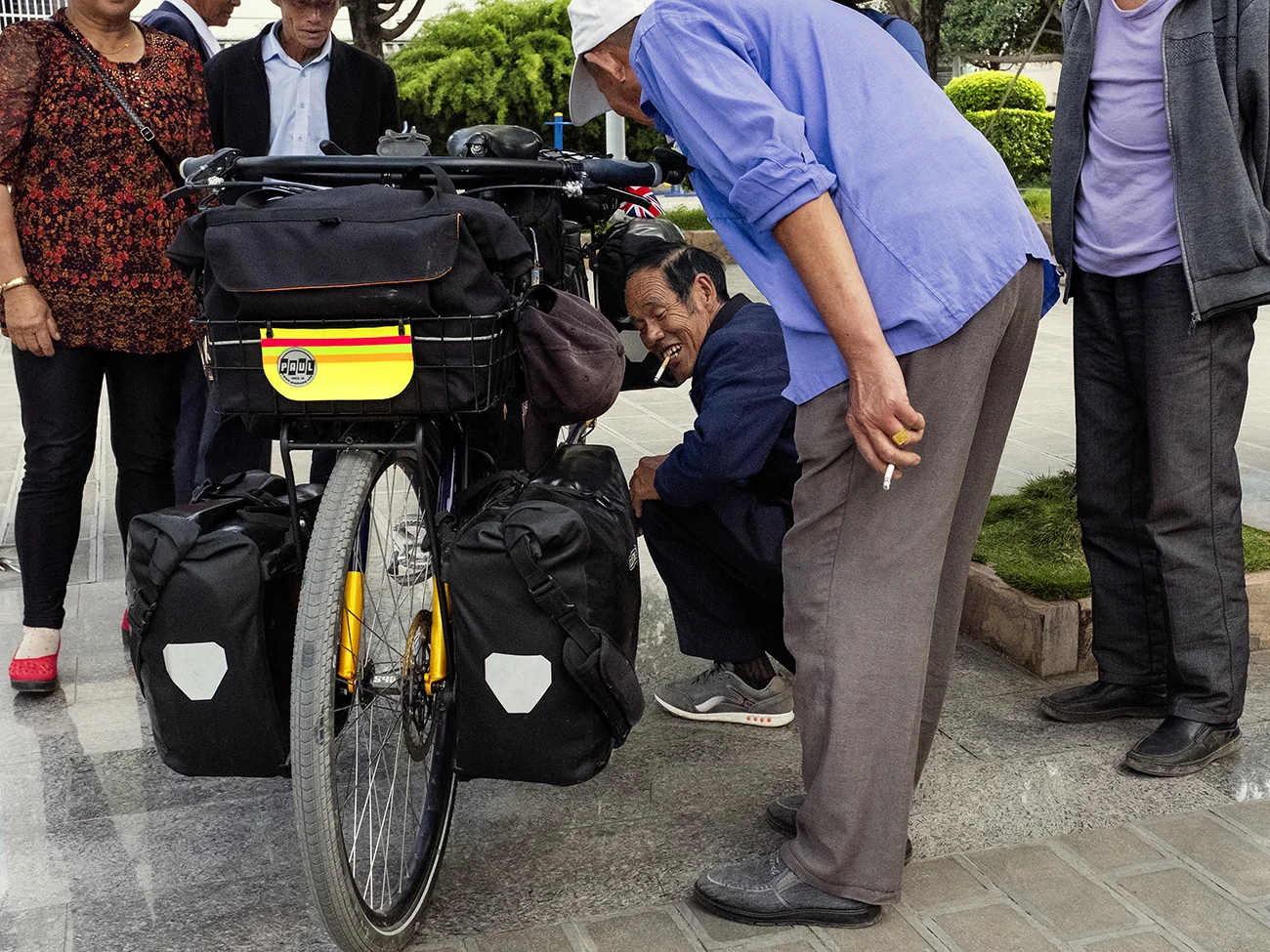

Brazilian Photographer Carol Sachs and her partner spent three years dreaming of their 15-month transcontinental trip, by tandem bike. Carrying little else apart from her cameras, Carol gradually sent film back to the UK as she travelled and from time to time was greeted by hundreds of scans of photographs of their life-changing trip. These definitely are not the kind of run-of-the-mill travel snaps you’ll see someone posting on Facebook during their gap year. Here Carol tells us how you go about planning a 15-month-long bike ride, and what to expect along the way.

Give us your route, in a nutshell.
Japan, South Korea, China, Vietnam, Cambodia, Thailand, Laos, back to Vietnam because we loved it so much the first time, back up to China to connect to Central Asia, then Kazakhstan, Kyrgyzstan, Tajikistan, Uzbekistan, Azerbaijan, Georgia, Ukraine, Moldova, Romania, Hungary, Slovakia, Austria, Germany and Switzerland, ending at my brother’s house in Zurich.
Can you talk me through the reason why you wanted to do this trip? Particularly why you wanted to cycle, and why this particular length?
My mother and I had our 60th and 30th birthdays the same year and celebrated together with a 10-country, two and half month trip. At some point I noticed we'd been travelling long enough for the worries I had before, in the life I’d temporarily left, to no longer hold much power over me. They felt blurred, almost abstract. All the while returning was still too far away for future worries to occupy much of my mind. It was a powerful feeling of both presence in the moment and suspension from regular life.
I came home and told my partner about this incredible feeling, and how I wanted to experience it again, with him. That I wanted us to go on a very long trip. While I was away though, he’d had a spark of his own. He'd read Dervla Murphy’s Full Tilt, the story of her solo bike trip from Ireland to India in the ‘60s. I was open but not immediately convinced because I was not a cyclist at all. I only learned to ride a bike properly at the advanced age of 28 and, though I loved it, I was still far from proficient. To this day I still feel insecure on the road, still get off and push if traffic is too heavy or too fast.
Then we were introduced to the wonderful world of tandem bikes and suddenly it seemed more feasible. I could ride without having to navigate traffic! We did a ten day test tour through France that summer to see if we would actually like being on a bike all day every day and camping most nights, and we loved it. From then it still took three years for our work and schedules to align and we left without an end date. That was the most liberating of all. We wanted to ride as long as our money and love of the road lasted.


Were you nervous? If so, what were you scared of?
My only photographic agenda was not to have one, which was a bigger challenge than it sounds.
We were both particularly scared of the Pamir Highway in Kyrgyzstan and Tajikistan. Everything we read about it sounded scary: long, remote stretches of awful roads, insane winds, no shops, no towns, no people, no trees. Just a big expanse of ragged peaks, high altitude, airless desert and diarrhea. Everyone seemed to get a case of it. Also, my partner had a bad history of altitude sickness, but we did it!
It was every bit as beautiful as we expected and full of other cyclists with whom we shared a camp spot here, the floor of a basic guesthouse there, or a makeshift picnic lunch on the side of the road. I did have diarrhea and cried, weak and airless, up the highest pass at 4655m (15,272 ft), but at this point it wasn't scary anymore. It was tough, yes, but not as extreme, lonely or insurmountable a challenge as we had feared. Except for the wind: an incessant, bullying arse of a headwind, the kind that makes one crazy.


How does one actually go about planning a trip like this? From the minutiae to the larger stuff.
It is actually a lot less daunting than it seems and it's also, of course, hugely exciting. We focused first on the big stuff: insurance, visas and gear (especially the bike). We also had to leave our house and get rid of most of our stuff.
But, with the amount of people doing some form of this trip every year, from Europe to Asia or Asia to Europe, there are loads of resources out there. We took full advantage of all the blogs and Instagram accounts before and during the journey and that made it all much easier.
With a project so big and time consuming, did you know what you wanted to communicate with it, or did that come later?
It was first and foremost a life project. We wanted to experience the world ourselves, and ourselves in the world. Though we did consider a bunch of different ways in which to have a predetermined outlet for our experiences, ultimately what felt right for us was to first live it and give ourselves the time and space to process it all and then, if we felt the urge to, see how we could coherently put it all together.

Creatively how did you challenge yourself on this trip? Was there anything you wanted to push or try out in your work?
My only photographic agenda was not to have one, which was a bigger challenge than it sounds. I had spent the previous nine years working hard and was very fortunate to have had a lot of jobs and worked with brilliant people, which was wonderful. But I was feeling a bit of burnout, so I wanted to allow myself the freedom to only shoot what took my fancy, to not be “on” all the time.
At first it was hard to shake a specific assignment mindset, the question of "What does this project need?" running constantly in the background. But eventually I did manage to relax and take the attitude of freedom with which we were approaching the rest of the trip onto the photographic part as well.


Is there any advice you'd give someone who was about to do a trip like this?
A good lesson we learned early was to make and accept our own trip. We went in with a certain preconceived idea of how a trip like that is done: you rough it, you camp, you spend only when absolutely necessary, you ride a minimum per day, you suck it up. When we didn’t manage to live up to this, succumbing to a hotel room with air conditioning in Japan even though it was double our daily budget, or when we had a short day because we were tired, or took a train to avoid a particularly ugly and industrial stretch of road, it felt like a failure. Like we were letting ourselves and the trip down, like we were not doing it right. Which is silly, of course. There are countless ways of doing any trip and we did a better service to ourselves finally accepting that perhaps our journey wasn't going to score that many rad points in the hardcore adventure circles, but we were the ones living it, and we had to enjoy it.


It was a powerful feeling of both presence and suspension from regular life.

Did you get into any scrapes?
Not really, thankfully. I think the biggest hurdle were three herniated discs on my lower back, which all decided to give around the end of our second month on the road in a small town in China.
That meant a few weeks off the bike, much of it spent in a lot of pain in bed, or trying to go for strolls bent in half, some funny visits to hospitals, an unforgettable masseuse and a sadistic doctor who’d twist acupuncture needles onto my bare ass in front of other patients and bemused onlookers until I literally screamed (which he found very funny). Both my back and my sense of dignity did eventually recover in full though.
Who was the best person you met?
So many! If I had to pick one though it would be Davide, a blind Italian cyclist riding from Italy at the back of a tandem with his friends Samuele and Gino. We met them at The Green House Hostel, itself a highlight of the trip, in Dushanbe, Tajiskistan, the place where most cyclists stay at the start or end of the various routes through the Pamirs. Gino would sit under the big tree in the courtyard with the Italian press and coffee they'd carried all the way from Italy, and share with everyone that stopped for a chat, surrounded by bikes and bike parts, drying tents and sleeping bags, everyone fixing, cleaning, mending before or after facing the mountains. All the while Davide dealt with everyone's amazement with a great sense of humour, the sort that immediately put to bed any sign of pity or condescension. The awe remained though, the rest of us cyclists unable to imagine going through the efforts of the road without the views as reward. But he was undeterred, and the pleasure he found in everything was obvious and contagious. They were also travelling to raise awareness about disabled athletes, doing meetings and talks along the way and at the end of their trip donated their tandem to a blind athlete in Tajikistan.

Which camera were you using and what kind of film? Were you processing film en route?
I started with my trusted Fuji GFX and a Contax T3, which I had never used before, and which turned out not to be a good fit for me. When we got to Seoul I swapped it for a Contax G2, a camera I had loved for years but had left at home in favor of the tiny T3. At some point I used a Fuji X100F, but eventually settled for the G2 and a Sony A7RIII. This turned out to be a good compromise in terms of size/weight and image quality. I used Kodak Portra 400 film all the way, and shipped the film to my lab in London whenever I found myself somewhere I could trust the postal system.
Physically and mentally, how did you prepare for this journey?
I didn’t prepare physically at all and paid the price dearly from about day two on the first mountain we had to climb in Japan. The truth is I am lazy when it comes to exercise, so in my mind why train if I would exercise every single day anyway? Fitness was inevitable. Fitness would also have been nice in a country as mountainous as Japan, with roads as steep as Japan’s, from day one. It took at least three weeks for the inevitable to kick in.

I'd love to know more about the actual biking part, how far were you biking per day and for how many hours?
It varied wildly. Our shortest day was 12km and our longest was 135km. And because we like to stop and linger so much along the way, we ended up spending around eight hours on the road each day, often more.
Where had the tastiest food?
Japan, South Korea, Vietnam and Thailand were all wonderful, but I think China was the most exciting.


How much could you carry with you, and was that a problem?
On a tandem you can only take about half as much as two people on single bikes. So we had one pannier each for our clothes, one for our documents, computers and cables, and one for sleeping bags and cooking gear. Then a frame bag with the tent, another with tools and small things we used often like sunscreen, a basket at the back with sleeping mats and a basket bag at the front with other often used items and snacks. I also had a camera bag attached to the handlebars for easy access while riding.
What did you learn about yourself, your relationship, and humankind?
The million dollar question! And an unoriginal reply, I’m sorry. But it does seem kind of inevitable that most cyclists we met or whose stories we'd read seemed to have learned the same thing: that the world is a much less scary place than we believed.

